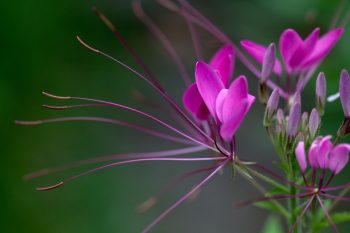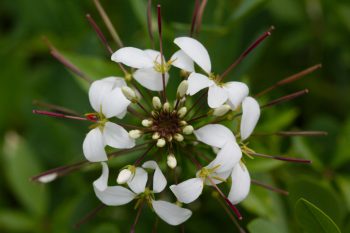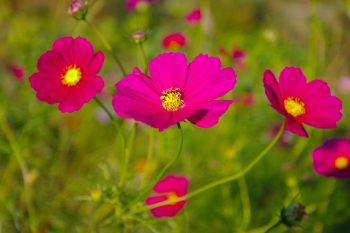Nigella damascena, otherwise known as love-in-a-mist, is a very pretty annual. It grows easily from seed and is a good choice for a sunny spot in the garden.
Tagged With: Annual
Love-In-a-Mist
Nigella Seed Capsule
Back on May 24 (day 144) I had a picture of a Love-In-a-Mist (Nigella damascena) flower. This is the seed capsule, which is also pretty cool. I didn’t take this until after dark so it’s taken with a reflected flash.
Cleome hassleriana
Commonly known as spider flower, Cleome hassleriana is a really nice plant. It’s probably just as well that it’s an annual or it might get out of hand. This is its first bloom of the summer in our yard and it should continue until early fall.
Deep Orange Zinnia
In the small garden where the county once had an oak tree, down by the road, Cathy has been growing mostly annuals each summer. We got a lot less done in the yard this year but she did manage to get a bunch of zinnia and marigold plants in the ground. There is Pachysandra terminalis already growing around the bed but she has kept the center, where the tree was, clear for her annuals. There is also Conoclinium coelestinum (Blue Mistflower), a slightly invasive herbaceous perennial, but she pulls out enough each year to keep things balanced. The blue of the Conoclinium goes well with the yellow and orange of the zinnias and marigolds.
Veronica arvensis (Corn Speedwell)
It was a beautiful day and I took the opportunity to go out and take a few pictures in the empty lot next to my office. Although we had a lot of rain this winter and early in the spring, April has been relatively drier than usual (at least that’s how if feels, I haven’t checked the actual data). Nevertheless, the drainage pond that is usually dry in the summer was about has high as it can be without the entire upper area being a bog. In a slightly higher part of the area I found quite a bit of this little corn speedwell (Veronica arvensis) growing. It’s a native to Europe and has been introduced widely in North America (according to the US Department of Agriculture, it can be found in every state except North Dakota, and I wouldn’t be surprised if it’s actually there, too. The blooms are quite small, only about a quarter inch across, and are a lovely blue color. As weeds go, there are worse.
Cleome ‘Senorita Blanca’
On Sunday, as I mentioned, we went to Stadler Nursery in Laytonsville. Cathy bought a few things, including two Cleome plants, one white and one very pale pink. The white one, shown here, is called ‘Senorita Blanca’ and the other is ‘Senorita Mi Amor’. We’ve had Cleome ‘Senorita Rosalita’ in the past and these are (I assume) related plants with different coloration. My understanding is that they are sterile and will not self-seed, which is both good and bad. Annuals that do self-seed can become a real nuisance and get out of control. But some, if they only just manage to hold on, are really nice. Nigela is a good example of the latter. In our experience, it just self-seeds enough that we have it for a few years before needing to plant more. Other annuals, of course, go totally native and sterile plants are a real boon.
Cleome ‘Senorita Blanca’
My back was up to a full day’s work today. Although there were a few rough spots I made it through, trying to get up now and then to move around (because “Motion is Lotion” as they say). When I got home I took pictures of various flowers in the back yard. I really thought it would be pushing it to get down on the ground for photography. I did for the caterpillar photo yesterday but getting back up was a chore. So, I sat in a chair and photographed what was all around, including blue Lobelia, butterfly weed, Lantana, and a few other flowers. I like the Cleome with the black-eyed Susan flowers behind it.
Zinnia
This spring Cathy planted some zinia and marigold seeds. She’s talked about doing that for a few years but this year she actually got them planted. They grew under a plant light in our dining room in the late winter and into the early spring. They probably were started a little early because by the time it was safe to plant them outside they were a bit leggy and had already started to bloom. Still, I’d say they constituted a success. This one is growing in a pot on the back patio and it has pretty flowers. Not a lot of them, but every little bit counts.
Veronica persica (Persian Speedwell)
I went outside today in the early afternoon and walked to the empty lot next to my building. It still looks mostly brown but there are little bits of color if you look hard enough. The seedling pears are just about to start blooming and there is a small amount of pink in their otherwise white buds. The hairy bittercress (Cardamine hirsuta) is starting to bloom everywhere. Those flowers are white and not terribly conspicuous. Even less conspicuous because they are so small are the beautiful, tiny blue flowers of Persian speedwell (Veronica persica, also known as bird’s-Eye speedwell). You really have to look for them, but once you start to see them, you’ll notice them everywhere.
Marigold ‘Durango Red’
As mentioned on Sunday, we went to the garden center to buy plants for Cathy to put in containers and into the ground for the summer. These were mostly annuals, although we did buy a few perennials, as well, including a rosemary. This is one of the marigolds that Cathy picked out. It’s called ‘Durango Red’ and it’s a really nice, burnt orange color. It’s especially nice in the rain, which was heavy today. This is out on the driveway right now but it will probably go into the ground before too long. They are a quick and easy way to get a lot of color in your garden.
Evolvulus ‘Blue My Mind’
This is yet another tender perennial grown here as an annual. It’s a non-vining, morning glory-like plant native to Brazil. It’s a member of the convolvulus family (a.k.a. the bindweed or morning glory family, Convolvulaceae) but it doesn’t twine and the genus, Evolvulus, means to untwist or unravel. This variety, ‘Blue My Mind’, has beautiful, pale, sky-blue flowers about an inch across. This does really well in hanging baskets or other containers and that’s where this is destined to go, but so far it’s among the plants waiting to be potted up.
Cosmos bipinnatus ‘Sonata’
I’ve seen some really impressive plantings of cosmos (Cosmos bipinnatus) but we’ve never had enough to really make a huge impression. Some years I think about getting a few packets of seeds but never seem to get around to it at the right time. This is from the ‘Sonata’ series and it a lovely color. They will self seed, if you’re lucky, and you’ll get repeat bloom from year to year, but we’ve only had an occasional plant from seed. Maybe next spring I’ll actually get my act together and put some seeds down. This and Nigella damascena (love-in-a-mist) are two that I think I could stand a lot more of.
Cosmos
I took more photos of the Scudderia (a genus of katydid) nymph today. It’s still in the canna lily flower and still eating the petals. I suspect it will move on pretty soon. That or it will be eaten, of course. This cosmos is growing in a small pot on our patio. We’ve never really grown them much, but they sure do add a lot of color to a garden in summer. We could do worse than have lots of them.
I also took a few photos of a dinner we had with a dear (and winsome!) friend, who has been living with her recently widowed mother-in-law. But they don’t really do justice to the great time we had.
Yellow and Orange Purslane
Common purslane (Portulaca oleracea) is a noxious weed where it is warm enough for it to survive through the winter. Here it is grown as an annual and it’s the large-flowered cultivars that are grown here, specifically for their flowers, which are present pretty much all summer. The flowers are generally open in the morning and then close up when the day gets hot, but on an overcast day they might stay open all day. Their colors are really something and we’ve loved having them outside our kitchen door this year. In case you’re wondering (I was, so I asked Cathy), the purple flower is Torenia fournieri, commonly known as wishbone flower, an annual that has also done exceptionally well this year.
Torenia ‘Summer Wave’
We’ve grown Torenia fournieri before but I don’t think it has ever done as well as it did this year. We have a couple of them in containers on the back patio and they have been in constant bloom all summer and will probably not stop until we get a killing frost. They are also known a wishbone flower because the stamens join to form a shape similar to the wishbone of a chicken. This one is a variety called ‘Summer Wave’. Ours got a bit of sun but they are also really good for shade. You better believe we’re going to get this again next year.
Nigella damascena (Love-In-A-Mist)
We were out at Rocklands this morning with Dorothy for their chick-rental pick-up. I took a walk at one point to take some pictures of Anna’s flowers. It was a wet, cool day and there isn’t a lot in bloom at the moment but the love-in-a-mist (Nigella damascena) was blooming. The flowers are a lovely shade of pale blue and I think it’s even prettier in the rain, with water droplets on the various flower parts. This is a very hardy annual, growing well up to USDA Hardiness Zone 2, although it’s only native to northern Africa and southern Europe.
Celosia At Sunset
We went out to Rocklands this evening and I took a few late-day photos in the garden. I really enjoyed the light and I’m pretty happy with this photo, which I assume is celosia, commonly called woolflowers. Celosia is a genus of plants in the amaranth family. The name is from the Greek word κήλεος (kḗleos), meaning “burning” and refers to the flame-like flower heads. These are growing in Anna’s garden for use in flower arrangements. They certainly are lovely. A little later we met Dorothy and some of her friends and had a nice time eating, drinking, and talking.
Cosmos bipinnatus
We stopped at Rocklands this afternoon after a fairly long walk on the C&O Canal, starting at Violet’s Lock and heading southeast well past Blockhouse Point. We saw a few herons and a lot of turtles and enjoyed the walk quite a bit. I took pictures there but really like this one of cosmos blooming in the historic garden at Rocklands, which Dorothy is in the process of weeding and renovating. It’s a large garden and there’s a lot to be done, but the flowers that are there are quite spectacular.



















